Act II
Theories proposing that something other than Flight 77 was responsible for the damage done to the Pentagon on September 11, 2001 have been harshly criticized in some quarters. Two of the most frequent criticisms that I have read are: (1) the researchers promoting such theories have never been to the D.C. area to view the crime scene, so they don't really know what they're talking about; and (2) promoting such theories can only serve to alienate people in the D.C. area, since so many of them allegedly saw the errant aircraft.
I don't find either of these criticisms particularly valid. Millions of people, after all, have never visited Dallas to stand in Dealey Plaza, but they have still been able to objectively review the evidence and conclude that the official story of the JFK assassination just doesn't add up. Likewise, millions of people have never visited the Ambassador Hotel in Los Angeles, and yet they have been able to draw conclusions about the RFK assassination after reviewing the evidence. I fail to see why the same rules shouldn't apply to the attack on the Pentagon.
As for the witnesses, there were actually relatively few, and an unusually large percentage of those who lent support to the official story were either career military types or media representatives. Some of the witnesses reported seeing an aircraft much smaller than a 757, possibly even a missile. Mike Walter, for example, told CNN that what he saw "was like a cruise missile with wings, went right there and slammed into the Pentagon. Huge explosion, great ball of fire, smoke started billowing out, and then it was just chaos on the highway."
(http://www.cnn.com/2001/US/09/11/pentagon.terrorism/http://www.cnn.com/2001/US/09/11/pentagon.terrorism/)
Witness Tom Seibert told the Washington Post that he "heard what sounded like a missile, then we heard a loud boom." The same Post article revealed that "Ervin Brown, who works at the Pentagon, said he saw pieces of what appeared to be small aircraft on the ground." Needless to say, a Boeing 757 would hardly be considered a "small aircraft." (http://a188.g.akamaitech.net/f/188/920/5m/www.washingtonpost.com/wp-srv/metro/daily/sep01/attack.html)
The Post also spoke to a Steve Patterson, who said that he saw the plane from about 150 yards away, "approaching from the west about 20 feet off the ground." He described the plane as having "the high-pitched squeal of a fighter jet," and he said that it "flew over Arlington cemetery so low that he thought it was going to land on I-385. He said it was flying so fast that he couldn't read any writing on the side." Patterson also said that the aircraft that he saw "appeared to hold about eight to 12 people" -- hardly an aircraft of sufficient size to be a 757. And a bulky 757 is certainly not the type of aircraft that you would expect to be observed approaching the Pentagon "below treetop level," as this one purportedly was.
The UK's Guardian began its initial report on the Pentagon attack with
the words: "It sounded like a missile at first, the air above Washington filled
with the terrifying roar of displaced air." One witness questioned by the
Guardian claimed, strangely enough, that "the blast had blown up a
helicopter circling overhead." Of course, since no photographic evidence of the
crash has been produced, there is little hope of either confirming or disproving
this claim.
(http://www.guardian.co.uk/Archive/Article/0,4273,4254934,00.html)
Yet another witness account of the attack, this one from a reporter for Space.Com, reads as follows: "At that moment I
heard a very loud, quick whooshing sound that began behind me and stopped
suddenly in front of me and to my left. In fractions of a second I heard the
impact and an explosion. The next thing I saw was the fireball. I was convinced
it was a missile. It came in so fast it sounded nothing like an airplane."
(http://www.space.com/news/rains_september11-1.html)
It also moved nothing like a passenger airplane, at least on radar. Air
traffic controller Danielle O'Brien, who had earlier that morning cleared Flight
77 for take-off from Dulles, certainly didn't think it was a Boeing 757 that she
was tracking on radar as it approached Washington. What she initially saw was
"an unidentified plane to the southwest of Dulles, moving at a very high rate of
speed ... I had literally a blip and nothing more." O'Brien described her
impression of the projectile that she tracked: "The speed, the maneuverability,
the way that he turned, we all thought in the radar room, all of us experienced
air traffic controllers, that that was a military plane. You don't fly a 757 in
that manner. It's unsafe." The consensus opinion among the controllers, after
tracking some of the movements of the projectile, was that it "must be a
fighter. This must be one of our guys sent in, scrambled to patrol our capital,
and to protect our president." Of the final portion of the aircraft's
destructive journey, O'Brien has said: "We lost radar contact with that craft.
And we waited. And we waited."
(http://www.abcnews.go.com/sections/2020/2020/2020_011024_atc_feature.html)
As any student of the law knows, even the most sincere, well intentioned witnesses can be, and frequently are, mistaken about what it was that they witnessed (especially during times of extreme stress). Add to that the fact that there is a virtually unlimited supply of potential 'witnesses' in the D.C. area who aren't so well intentioned, and it begins to look like witness reports may not be the best way to get at the truth of what happened at the Pentagon on September 11, 2001.
Simply put, the photographic evidence, which trumps the contradictory witness statements, does not support the theory that an enormous commercial aircraft smashed into the Pentagon. I first reviewed some of that evidence in Newsletter #7 (June 30, 2002). Here I will present a thoroughly revamped version of that posting, incorporating a number of additional photographs, a discussion of why my initial theory is not supported by the evidence, and a review of some of the humorous 'evidence' that defenders of the official story have presented.
It is interesting to note, by the way, that the Pentagon was not evacuated on the morning of September 11, 2001, even though it was widely believed to be a potential target, and even though a projectile was reportedly being tracked on radar heading in its direction. More than 20,000 people are employed at the Pentagon, all of them potentially at risk that day. If the building had been evacuated, two things would have happened: lives would have been saved; and thousands of people would have been milling about outside the Pentagon, well positioned to witness whether Flight 77 did indeed crash into the Pentagon.
I should also note here that early media reports mentioned nothing about a passenger airplane. Some reports held that either a truck or a helicopter was involved in the attack. Fox News, that pillar of responsible journalism, initially reported that the Pentagon had been hit by a USAF fighter jet. Unlike in New York, the airplane story took time to fully take shape.
Although I refer frequently in this article to the "official story," there really isn't, technically speaking, an official story of what happened at the Pentagon that day. What there is instead is an officially encouraged, and notably vague, group consensus -- a consensus shaped and reinforced by Washington's political and media institutions, which have carefully avoided fleshing out too many details. This strategy is apparently intended to disarm critics, since it is much harder to point out the lies and absurdities in the official story if that official story has never been formally presented.
What the (un)official story says is that Flight 77, flying at a high rate of speed while mere feet off the ground, plowed into the side of the Pentagon at about 9:38 AM on the morning of September 11, 2001. Initial statements indicated that the only components of the aircraft to survive the impact and subsequent fire were the black boxes and a single landing light. The black boxes have never been turned over to civilian authorities and their contents have never been publicly revealed.
The failure to recover the rest of the aircraft was unofficially attributed to the fact that the entire plane was vaporized by the fire. Let me repeat that: the aircraft was vaporized by the fire. Not just melted into a pool of molten metal, mind you, but literally boiled away! Over 100 tons of metal, including two five-ton aircraft engines!
Although it should be obvious to any thinking person, it must be stated here anyway: a hydrocarbon fire cannot possibly burn at the temperatures required to even melt a 100 ton aircraft, let alone actually vaporize it. That such an absurd notion was even floated out there for public consumption indicates that Washington officials were desperately seeking any explanation, no matter how preposterous, for the complete lack of aircraft wreckage recovered from the Pentagon.
While the aircraft did not survive the ordeal, the remains of the passengers allegedly did. All but a handful were purportedly positively identified through forensic analysis. Apparently the fire in the Pentagon burned hot enough to vaporize steel aircraft engines, but not hot enough to cremate human remains. Sounds reasonable to me. (http://www.dcmilitary.com/army/stripe/6_48/national_news/12279-1.html)
The attack on the Pentagon reportedly damaged an enormous chunk of office space, and yet, curiously, only 125 people were killed on the ground, with another 80 seriously injured. As in New York, initial casualty estimates were substantially higher. Demolition and reconstruction began almost immediately, and within a year, some of the newly rebuilt offices were already ready for occupation.
Some later reports indicated that Flight 77 had not actually been vaporized, but was in fact largely recovered and reconstructed. Such claims have never been formally confirmed or denied by Washington officials. To date, there is no compelling evidence indicating that any aircraft debris was recovered from any part of the Pentagon.
Many questions have been left unanswered by the official story of the attack. For example, how could hijackers possibly have known that they would be able to fly unmolested for some 300 miles while headed directly into the heart of the nation's capital, through the most tightly controlled airspace in the world -- and do it not in a surprise attack, while the nation's defenses were sleeping, but rather while the country was on the highest state of alert, and actually anticipating the attack? ... while the whole world was watching, and all the broadcast and cable television networks were providing play-by-play coverage?
Wouldn't it have made far more sense for the Pentagon to be the first target struck, utilizing the element of surprise, considering that the home of U.S. military forces is obviously a little better defended than the World Trade Center? Wouldn't the logical way to implement the assault have been to hit the military command center first, then strike the civilian targets while the military was attempting to regroup and secure Washington? You would think that even a third-rate terrorist would know that, let alone a terrorist superstar like Osama bin Laden.
Another question that has been raised is why there has never been any film or videotape released depicting an airplane approaching, or crashing into, the Pentagon. As the home of Uncle Sam's military machine, the Pentagon is quite obviously one of the most secure buildings in the world. It is under constant surveillance by multiple closed-circuit cameras. In addition to the Pentagon's own footage, surveillance cameras at a Sheraton hotel and a Citgo gas station were also positioned to record the 'crash.' Tape from both cameras was reportedly quickly seized by the FBI. None of the footage has ever seen the light of day. And despite the fact that an unusually high number of media personnel claimed that they witnessed the attack, no photographs or videotape of the attack have ever been released by any media outlet. With the exception of one notorious image that is purported to be a frame from a tape from one of the Pentagon's CCTV cameras, there is no photographic evidence of any airplane, of any size, flying in the vicinity of, approaching, or crashing into, the Pentagon.
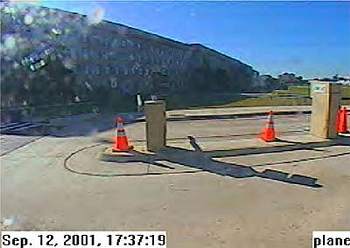
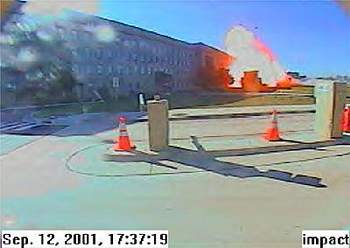
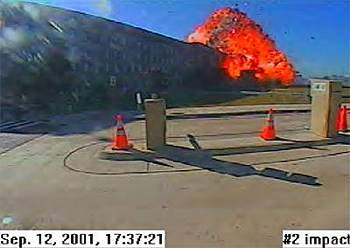

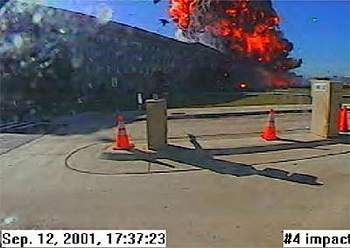
There are any number of curious anomalies in these images, perhaps the most obvious of which is the fact that the date/time stamps, added after the fact, are off by about thirty-two hours. The second frame differs from the other four in a number of ways: it is brighter, shifted slightly to the left, and obscured in both upper corners. The second frame also has the same time stamp, 17:37:19, as the first frame, though it obviously wasn't taken at the same time.
Some researchers, by the way, have claimed that the time stamps indicate a tape speed of 100 frames per second, which these same researchers have noted is extremely unlikely. These people apparently never learned how to tell time, so let me clue them in: the difference between 17:37:22 and 17:37:23 is one second, not 1/100 of a second. Time, you see, is generally recorded as hours:minutes:seconds. But no one should let that stop them from making stupid claims that further discredit the field of 9-11 research.
Another curious feature of the images can be observed by focusing your attention on the upper left corner of each frame -- the area where it looks like Bob Guccione snuck by and spread a little Vaseline on the camera lens. As can be clearly seen, the pattern of condensation drops (or whatever they are) is quite consistent in frames #1, #4, and #5, but much different in frames #2 and #3, as though the drops began to disperse and then inexplicably returned to their original configuration. Another curiosity is that the helicopter support structure that can be seen in silhouette in front of the fireball in frames #3 and #4 is incongruously painted a bright orange in frame #2.
What then are we to make of these images? Only one of the five purportedly shows an airplane about to crash, and it is of such poor quality that it is not possible to perform any sort of meaningful analysis. There is little question that the images have been manipulated in various ways, rendering them all but useless for shedding any light on what happened at the Pentagon on September 11, 2001. The most likely scenario is that these doctored photos were 'leaked' quite deliberately for the express purpose of further muddying the waters. We will therefore treat these images with the respect that they deserve -- which is to say, we will pretty much ignore them.
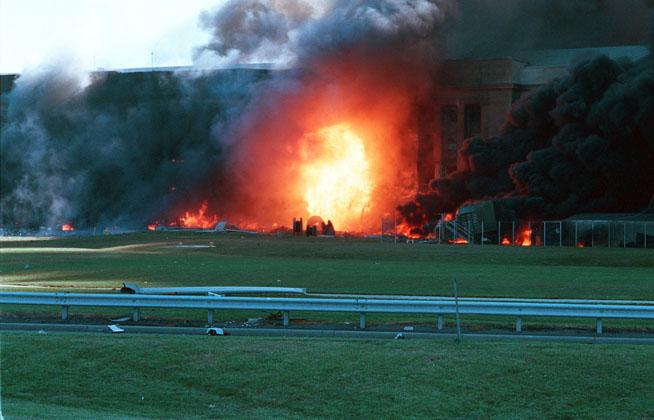
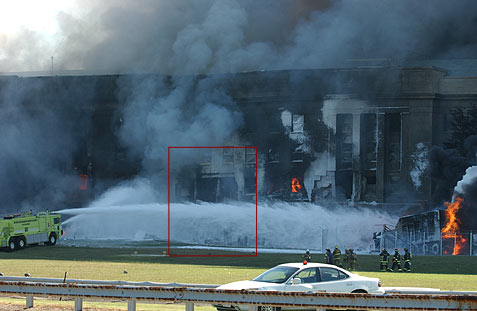 Unlike the
actual 'crash,' there is plenty of photographic evidence of the aftermath of the
attack. Virtually none of it supports the official story. Nothing that can be
confirmed as aircraft debris is visible in any of the photographs that have
found their way into the public domain. Photos do reveal, and Pentagon officials
have acknowledged, that the initial penetration into the side of the building
was not nearly large enough to account for the wingspan of a Boeing 757-200
aircraft (actually, the penetration wasn't even large enough to account for the
fuselage of a 757). In fact, all the available photos reveal that the initial
damage to the front facade of the Pentagon, after the alleged crash but before
the collapse that occurred about a half-hour later, was relatively minor. And
the impact apparently did not generate enough explosive force to even displace
the wire spools just below the alleged point of impact.
Unlike the
actual 'crash,' there is plenty of photographic evidence of the aftermath of the
attack. Virtually none of it supports the official story. Nothing that can be
confirmed as aircraft debris is visible in any of the photographs that have
found their way into the public domain. Photos do reveal, and Pentagon officials
have acknowledged, that the initial penetration into the side of the building
was not nearly large enough to account for the wingspan of a Boeing 757-200
aircraft (actually, the penetration wasn't even large enough to account for the
fuselage of a 757). In fact, all the available photos reveal that the initial
damage to the front facade of the Pentagon, after the alleged crash but before
the collapse that occurred about a half-hour later, was relatively minor. And
the impact apparently did not generate enough explosive force to even displace
the wire spools just below the alleged point of impact.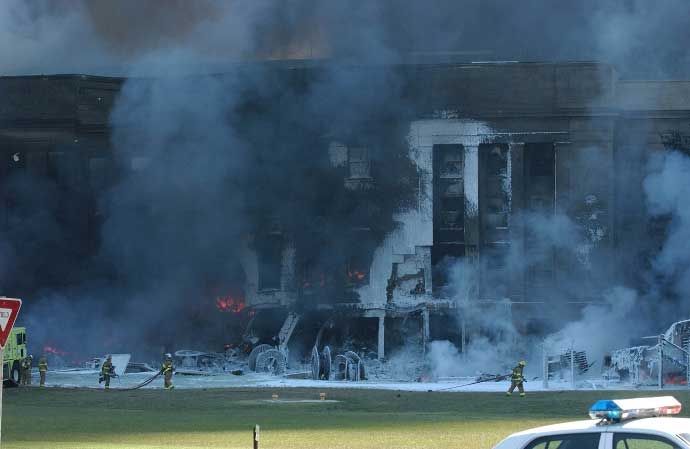 The
pre-collapse photos reveal that the front wall of the Pentagon remained
remarkably intact after the initial impact. Pentagon officials, and defenders of
the official story, have claimed that the small entry wound made by the alleged
plane was the result of the fact that the aircraft's wings were either sheared
off or folded back on impact, and that only the fuselage entered the building --
becoming, in effect, a very large missile. That would be a much more
plausible claim if a 757 did not have very large wings that would be clearly
visible in these photographs if they had in fact been sheared off as the
fuselage entered the building. Attached to those wings are two engines, each
about 9 feet in diameter, 21 feet long, and weighing nearly five tons. The
official story doesn't really bother to account for them.
The
pre-collapse photos reveal that the front wall of the Pentagon remained
remarkably intact after the initial impact. Pentagon officials, and defenders of
the official story, have claimed that the small entry wound made by the alleged
plane was the result of the fact that the aircraft's wings were either sheared
off or folded back on impact, and that only the fuselage entered the building --
becoming, in effect, a very large missile. That would be a much more
plausible claim if a 757 did not have very large wings that would be clearly
visible in these photographs if they had in fact been sheared off as the
fuselage entered the building. Attached to those wings are two engines, each
about 9 feet in diameter, 21 feet long, and weighing nearly five tons. The
official story doesn't really bother to account for them.One enterprising soul put together a composite image that illustrates, more clearly than any other image that I have come across, the fundamental absurdity of the official story of the crash of Flight 77. Seen below is an actual photo of the Pentagon, over which is overlaid both a properly scaled image of the pre-collapse damage to the facade on September 11, and a properly scaled image of a Boeing 757-200 aircraft.
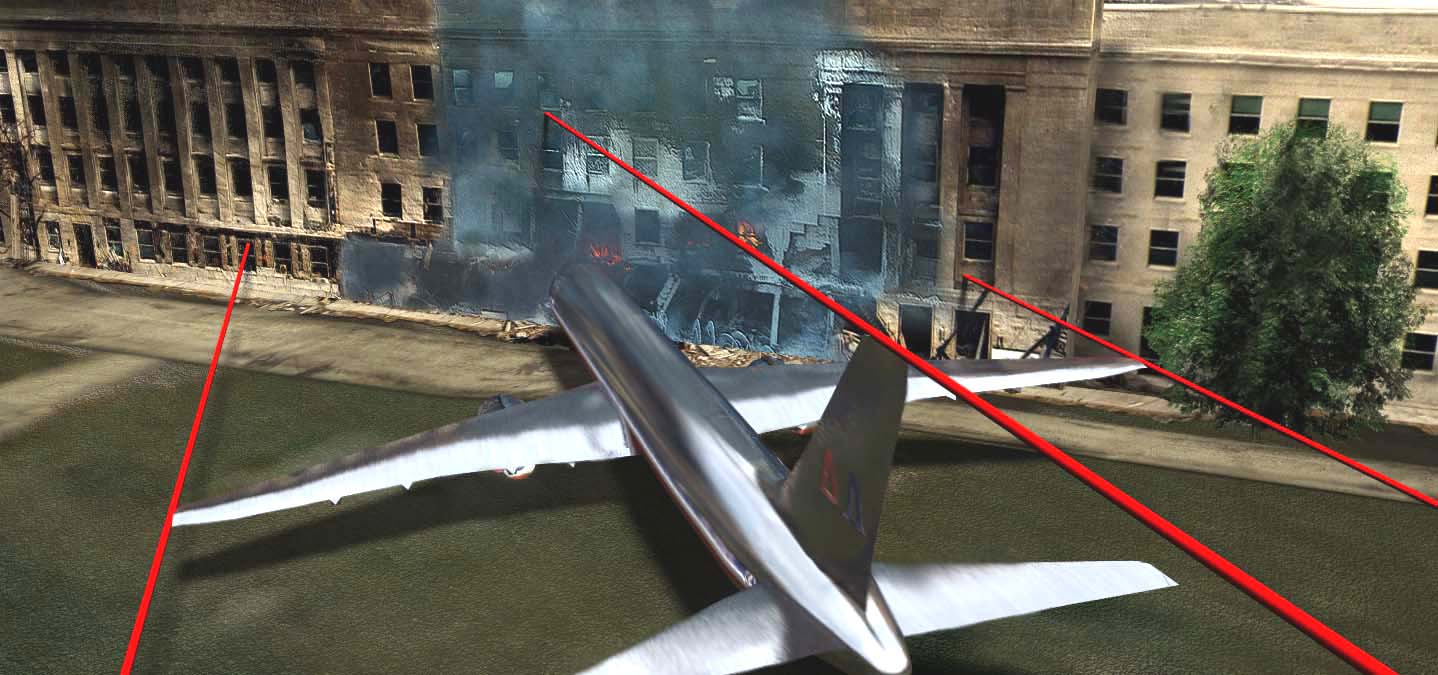
Perfectly obvious in this composite photo is that the actual impact damage to the Pentagon was entirely inconsistent with the crash of a large passenger plane. Also obvious is that even if we accept the dubious notion that the plane's fuselage disappeared within the building, some very large aircraft parts seem to be unaccounted for -- like the two wings, the two engines, and the three tail fins.
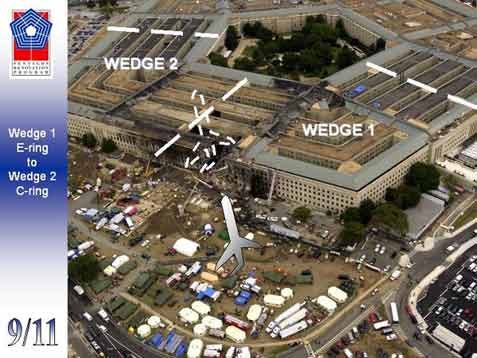
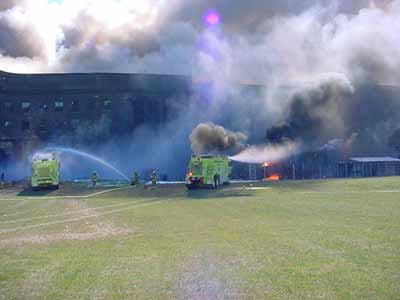 Nevertheless, the official story claims that the plane did in fact
impact the Pentagon exactly as depicted in the above photo, as can be seen in
the graphic to the right, which was used by Pentagon spokesmen during a post-911
press briefing. As can be seen in the graphic, Flight 77 allegedly plowed
through three of the five concentric rings that make up the Pentagon, coming to
rest completely within the complex of buildings. According to various 911
gatekeepers, that is why there is no aircraft debris visible on the lawn outside
the alleged point of impact (such as in the photo to the left). Also missing,
needless to say, is any indication that a 100 ton aircraft performed a
gymnastics floor routine on that lawn before slamming into the side of the
Pentagon.
Nevertheless, the official story claims that the plane did in fact
impact the Pentagon exactly as depicted in the above photo, as can be seen in
the graphic to the right, which was used by Pentagon spokesmen during a post-911
press briefing. As can be seen in the graphic, Flight 77 allegedly plowed
through three of the five concentric rings that make up the Pentagon, coming to
rest completely within the complex of buildings. According to various 911
gatekeepers, that is why there is no aircraft debris visible on the lawn outside
the alleged point of impact (such as in the photo to the left). Also missing,
needless to say, is any indication that a 100 ton aircraft performed a
gymnastics floor routine on that lawn before slamming into the side of the
Pentagon.After the collapse, there was still no aircraft wreckage visible, as can be seen in these post-collapse photos -- the center one taken just after the collapse, while the fire still burned, and the other two taken after clean-up efforts were underway. According to the 911 gatekeepers, the remains of the aircraft were at that time still buried beneath the collapsed building. Fair enough. That seems to be a reasonable enough claim -- except for the fact that only the outer ring of the Pentagon collapsed, while the plane, according to the official story, penetrated through two additional rings, neither of which collapsed, and neither of which yielded any verifiable aircraft debris. And if any aircraft debris was later found buried beneath the collapsed portion of the Pentagon, no one bothered to document it with photographs.
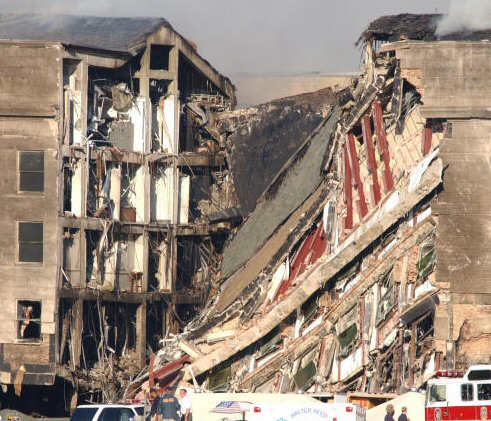
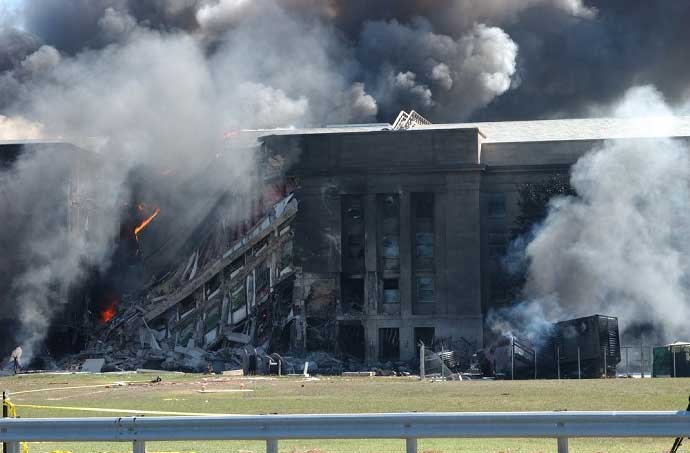
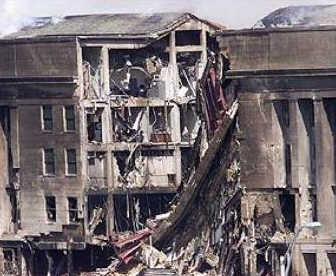
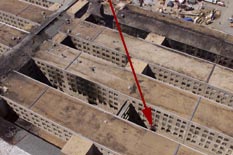
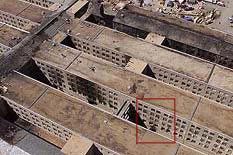 Sometimes
offered in support of the official story is photographic evidence of an exit
wound exactly where we would expect it to be located if an airplane, or some
other fast moving projectile, did in fact slice through the concentric rings of
the Pentagon in the manner indicated in the official Pentagon graphic. Punched
through the inside of "C" ring, at ground level, was a remarkably clean hole
that appeared to measure roughly 8'-9' high and 10'-12' wide. This hole, punched
through a thick, steel-reinforced masonry wall, was purportedly made by the
nosecone of Flight 77. There is no indication, however, in any of the photos, of
aircraft debris either inside or outside of the
hole.
Sometimes
offered in support of the official story is photographic evidence of an exit
wound exactly where we would expect it to be located if an airplane, or some
other fast moving projectile, did in fact slice through the concentric rings of
the Pentagon in the manner indicated in the official Pentagon graphic. Punched
through the inside of "C" ring, at ground level, was a remarkably clean hole
that appeared to measure roughly 8'-9' high and 10'-12' wide. This hole, punched
through a thick, steel-reinforced masonry wall, was purportedly made by the
nosecone of Flight 77. There is no indication, however, in any of the photos, of
aircraft debris either inside or outside of the
hole.